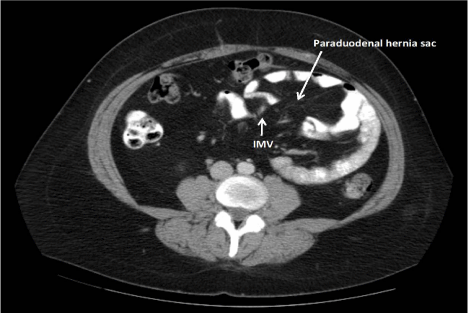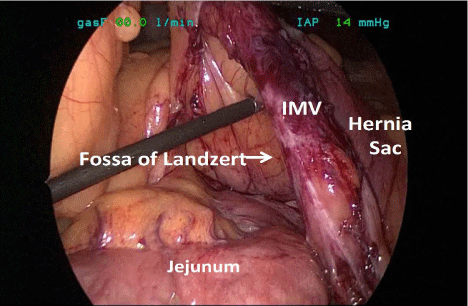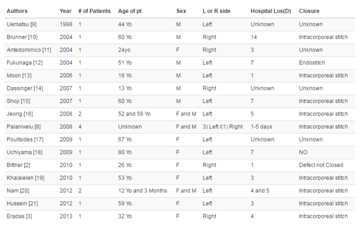Case Report
Laparoscopic Repair of Paraduodenal Hernia: Feasibility and Technique
Iqbal A,1* Cuenca A2 and Jameel R3
1Department of Surgery, University of Florida, USA
2Department of Pediatric Surgery, Boston Children's Hospital, USA
3Department of Medicine, KSA
*Corresponding author: Atif Iqbal, Department of Surgery, University of Florida Gainesville, Florida, P. O. Box 100109, Gainesville, FL 32610, Florida, USA
Published: 27 May, 2016
Cite this article as: Iqbal A, Cuenca A, Jameel R. Laparoscopic Repair of Paraduodenal Hernia: Feasibility and Technique. Ann Clin Case Rep. 2016; 1: 1005.
Abstract
Purpose: Internal hernias are a result of bowel protrusion through a normal or abnormal intraabdominal mesenteric defect. Paraduodenal hernias comprise the most common form of congenital
internal hernia however, due to the rarity of this condition, there is no consensus regarding standard
of care for the surgical treatment of these hernias. We report a successful laparoscopic repair of a left
sided paraduodenal hernia with a modified technique involving plication of the hernia sacalong with
a literature review to establish the feasibility of a laparoscopic approach.
Methods: The diagnostic considerations, operative steps and follow up are presented. In addition, a comprehensive literature review was performed and operative as well as follow up data was compiled, when reported.
Results: After 24 months of follow up, our patient continues to be symptom free and without
evidence of recurrence. Our comprehensive literature search yielded only one recurrence in 23 cases.
In addition, only one laparoscopic case had to be converted to an open procedure.
Conclusions: Paraduodenal hernias need a high index of suspicion for diagnosis and could safely
be repaired laparoscopically with good outcomes, regardless of laterality. Plication of the mesenteric
folds comprising the hernia sac may help decrease recurrence and seroma rates but additional
studies are needed to elucidate this further.
Keywords: Internal hernia; Paraduodenal hernia; Laparoscopic repair; Technique
Introduction
Internal hernias, which are a result of bowel protrusion through a normal or abnormal intraabdominal mesenteric defect, are relatively rare but comprise approximately 1% of all small bowel
obstructions [1]. Paraduodenal hernias are the most common form of congenital internal hernias,
accounting to approximately 40-50% of the total [2-4]. Paraduodenal hernias are thought to be a
congenital defect of rotation and improper fusion of the mesenteric leaflets during fetal life that
creates small defects through which the bowel herniates [5] and can be either right or left sided. Left sided are the most common, comprising 75% of all reported cases. Most patients describe a
history of chronic intermittent colicky abdominal pain but can also present acutely with a small
bowel obstruction.
Diagnosis is often delayed and difficult due to the intermittent herniation and egress of bowel,
a low index of suspicion and non-diagnostic imaging. As a result, many patients proceed to the
operating room for exploration due to continued symptoms without a formal diagnosis and a
majority undergo open exploration [1]. Due to the rarity of this condition, there is no consensus regarding standard of care for the surgical treatment of these hernias. Few cases with laparoscopic
repair have been described but we report a successful laparoscopic repair of a left sided paraduodenal
hernia with a modified technique involving plication of the hernia sac along with a literature review
to establish the feasibility of a laparoscopic approach for repair of these hernias.
Case Report
A 36 year old female presented with a one year history of intermittent crampy abdominal pain that resulted in several visits to the emergency department. The episodes were associated with nausea and non-bilious vomiting but she denied any history suggestive of strangulation. All imaging studies done during these episodes over a period of several years were non-diagnostic except for one CT scan with oral contrast which revealed a large internal hernia to the left of the duodenum under the inferior mesenteric vein (IMV), consistent with a left sided paraduodenal hernia (Figure 1). The patient subsequently presented to us and was taken to the operating room after a thorough discussion. A diagnostic laparoscopy confirmed the diagnosis and revealed a large paraduodenal hernia with a majority of her small bowel herniating posterior to the proximal IMV, lateral to the ligament of Treitz, into a hernia sac posterior to the descending colon (Figure 2). Several adhesive bands tethering the bowel to the hernia sac were noted and divided. The hernia was completely reduced following which the leaflets of the hernia sac (posterior aspect of the left colonic mesentery and the retroperitoneal tissues) were approximated with interrupted silk sutures. The mouth of the hernia defect just lateral to the IMV was subsequently closed with interrupted sutures using an Endostitch device. Patient tolerated the procedure without complications and was discharged on postoperative day 3 on a regular diet. The patient continues to do well without any evidence of recurrence at 24 month follow up.
Figure 1
Figure 1
CT scan of abdomen demonstrating paraduodenal hernia in the presented case (IMV-inferior mesenteric vein).
Figure 2
Discussion
In this study, we report the diagnosis and successful laparoscopic repair of a left sided paraduodenal hernia with plication of the hernia sac as an added deterrence to future recurrence and seroma formation. A literature review is also done to demonstrate the efficacy of a laparoscopic approach for repair of these hernias.
Small bowel internal hernias account for almost 1% of all cases of intestinal obstruction [1], of which 50% are either due toleft orright sided paraduodenal hernias [2-4]. These typically arise in the fetal life due to malrotation of the midgut and left sided are the most common, comprising 75% of all cases, in which the small bowel prolapses through the Landzert's fossa, a congenital opening present in approximately 2 % of people [2,6,7]. This opening is a peritoneal fold formed by the inferior mesenteric vein and the ascending left colic artery. In contrast, right sided paraduodenal hernias are formed by prolapse of the small bowel through the Waldeyer's fossa, a small aperture behind the superior mesenteric artery and 3 or 4th portion of the duodenum [1]. This opening is congenitally found in less than 1% of people and compared to left sided hernias, the right sided hernias are often larger and more tethered [1,5].
Paraduodenal hernias do not have a typical presentation and most of the patients present with vague symptoms of intermittent episodic abdominal pain, nausea and vomiting which makes diagnosis difficult as was the case with our patient. A minority present to the emergency room with signs and symptoms of acute small bowel obstruction. Upper gastrointestinal series with small bowel follow-through or CT scans may reveal an oval hernia sac or a cluster of small bowel loops posterolateral to the duodenum, as it did with our patient [1]. However, these imaging modalities are typically non diagnostic either due to being done during a period of non-herniation or due to the presence of very subtle imaging findings which are easily overlooked. This was evident in our case by the numerous non-diagnostic imaging studies and the patient remaining undiagnosed for more than a year. Of note, the patient had a normal CT scan the day prior to her surgery while intraoperatively, a majority of her small bowel was found to be herniated which further exemplifies the intermittent nature of this disease and underscores the difficulty in radiologic diagnosis. A high index of suspicion and review of the imaging studies with an experienced radiologist is paramount for the diagnosis of this disease.
5.1. Literature review
A thorough literature review was done using Pubmed and Medline databases looking for laparoscopic paraduodenal hernia repairs to evaluate its frequency and efficacy and to try to find best practice guidelines for their surgical repair. No randomized trials exist for this condition so level one recommendation cannot be made, however, few case reports that do exist [8-21] have demonstrated the safety and efficacy of a laparoscopic approach for both left and right sided paraduodenal hernias (Table 1). Twenty threelaparoscopic cases in 18 publications between 1998 and 2014 have been reported, of which fourteen patients (61%)were left sided hernias. The mean age of diagnosis was 44 years and 53% patients were female. The symptoms at diagnosis were reported in all but two publications (89%) and when reported, the symptoms included abdominal pain (81%), nausea and vomiting (62%), constipation/obstipation (19%), bowel obstruction upon presentation (12%) and an asymptomatic incidental mass (6%). The chronicity of the symptoms was not specifically addressed in all publications but 25% of cases were reported to have chronic symptoms (Range: Two months to six years).
In all cases (100%) including ours, bowel was reduced laparoscopically with adhesions being taken sharply. The details of operative closure were mentioned in 78% of the publications. Of the ones that reported operative details, most patients (92%) had the mouth of the hernia defect closed with a permanent suture using either an Endostitch device (only one patient) or intracorporeal suturing(most patients) while in two patients (8%) the defect was not closed. Most cases were successfully repaired laparoscopically with no reported cases of conversion to an open procedure in the literature, regardless of the acuity of presentation or the presence of small bowel obstruction which is likely due to the proximal nature of the obstruction with these hernias. Only one case (4%) had to be converted to an open procedure in the current literature via an upper midline laparotomy [3]. In most cases, patients were discharged from the hospital between 1-7 days (Table 1).
Table 1
Table 1
Published case reports and limited case series reporting laparoscopic repair of paraduodenal hernias.
Long term follow up in not available in the literature with only two reports documenting follow up of 24 months in both cases [3,8]. Only two complications were reported in the literature with one patient having an intraoperative injury to the inferior mesenteric vein and one patient having a recurrence (4%). Of note, the patient with a recurrence had the mesenteric defect closed at the index operation with a recurrence noted at 18 months postoperatively which was subsequently repaired laparoscopically with a Gore-Tex plug [8].
We decided to not only suture the mouth of the hernia defect (Peritoneum overlying the IMV to the retroperitoneum, ligament of Treitz and the 4th part of duodenum) but also plicated the retrocolic hernia sac to prevent seroma formation and decrease the chances of recurrence. This is the first reported case with this technique modification, however, its efficacy in avoiding future seroma, recurrence and other complications will likely never be able to be objectively assessed due to the rarity of this condition. While a randomized trial would be ideally required to determine the best approach and technique for repair, the rarity of these hernias makes that unlikely.
Conclusion
Paraduodenal hernias account for 50% of all cases of internal hernias associated with small bowel obstruction. A high index of suspicion is needed for diagnosis due to the intermittent nature of the herniation, vague symptomatology and lack of sensitive diagnostic tests. Laparoscopic repair is associated with good outcomes in the limited numbers of published case reports. Defect closure with Endostitch device versus intra-corporeal suturing does not seem to affect outcome. Additional plication of the retrocolic hernia sac described by us may play a role in further decreasing complications such as seroma and recurrence rates.
Acknowledgments
We would like to acknowledge Juan Alvarez and Namrah Aijaz for their help with presentation and manuscript preparation.
References
- Berardi RS. Paraduodenal hernias. Surg Gynecol Obstet. 1981; 152: 99-110.
- Bittner JG, Edwards MA, Harrison SJ, Li K, Karmin PN, Mellinger JD. Laparoscopic repair of a right paraduodenal hernia. JSLS. 2009; 13: 242-249.
- Erdas E, Pitzalis A, Scano D, Licheri S, Pomata M, Farina G. Diagnosis and treatment of symptomatic right paraduodenal hernia: report of a case. Surg Today. 2014; 44: 192-196.
- Falk GA, Yurcisin BJ, Sell HS. Left paraduodenal hernia: case report and review of the literature. BMJ Case Rep. 2010; 2010.
- Bartlett MK, Wang C, Williams WH. The surgical management of paraduodenal hernia. Ann Surg. 1968; 168: 249-254.
- Tong RS, Sengupta S, Tjandra JJ. Left paraduodenal hernia: case report and review of the literature. ANZ J Surg. 2002; 72: 69-71.
- Berardi S, Testa I, Tirabasso F. [Technical solution in a case of peptic ulcer of the 2d duodenum (juxtapapillary)]. Minerva Chir. 1981; 36: 1519-1522.
- Palanivelu C, Rangarajan M, Jategaonkar PA, Anand NV, Senthilkumar K. Laparoscopic management of paraduodenal hernias: mesh and mesh-less repairs. A report of four cases. Hernia. 2008; 12: 649-653.
- Uematsu T, Kitamura H, Iwase M, Yamashita K, Ogura H, Nakamuka T, et al. Laparoscopic repair of a paraduodenal hernia. Surg Endosc. 1998; 12: 50-52.
- Brunner WC, Sierra R, Dunne JB, Simmang CL, Scott DJ. Incidental paraduodenal hernia found during laparoscopic colectomy. Hernia. 2004; 8: 268-270.
- Antedomenico E, Singh NN, Zagorski SM, Dwyer K, Chung MH. Laparoscopic repair of a right paraduodenal hernia. Surg Endosc. 2004; 18: 165-166.
- Fukunaga M, Kidokoro A, Iba T, Sugiyama K, Fukunaga T, Nagakari K, et al. Laparoscopic surgery for left paraduodenal hernia. J Laparoendosc Adv Surg Tech A. 2004; 14: 111-115.
- Moon CH, Chung MH, Lin KM. Diagnostic laparoscopy and laparoscopic repair of a left paraduodenal hernia can shorten hospital stay. JSLS. 2006; 10: 90-93.
- Dassinger MS, Eubanks JW. Laparoscopic repair of a right paraduodenal hernia in a child. JSLS. 2007; 11: 266-267.
- Shoji T, Nishiyama R, Oba K, Azuma M. Left paraduodenal hernia successfully treated with laparoscopic surgery: a case report. Case Rep Gastroenterol. 2007; 1: 71-76.
- . Jeong GA, Cho GS, Kim HC, Shin EJ, Song OP. Laparoscopic repair of paraduodenal hernia: comparison with conventional open repair. Surg Laparosc Endosc Percutan Tech. 2008; 18: 611-615.
- Poultsides GA, Zani S, Bloom GP, Tishler DS. Image of the month. Left paraduodenal hernia. Arch Surg. 2009; 144: 287-288.
- Uchiyama S, Imamura N, Hidaka H, Maehara N, Nagaike K, Ikenaga N, et al. An unusual variant of a left paraduodenal hernia diagnosed and treated by laparoscopic surgery: report of a case. Surg Today. 2009; 39: 533-535.
- Khalaileh A, Schlager A, Bala M, Abu-Gazala S, Elazary R, Rivkind AI, et al. Left laparoscopic paraduodenal hernia repair. Surg Endosc. 2010; 24: 1486-1489.
- Nam SH, Kim KW, Kim JS, Kim KH, Park SJ. Laparoscopic treatment of left paraduodenal hernia in two cases of children. Int J Surg Case Rep. 2012; 3: 199-202.
- Hussein M, Khreiss M, Al-Helou G, Alaeddine M, Elias E, AbiSaad GS. Laparoscopic repair of a left paraduodenal hernia presenting with acute bowel obstruction: report of a case. Surg Laparosc Endosc Percutan Tech. 2012; 22: e28-30.



